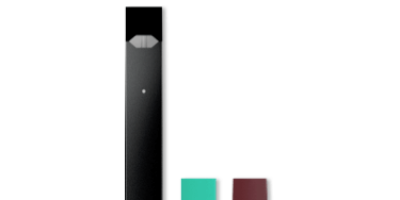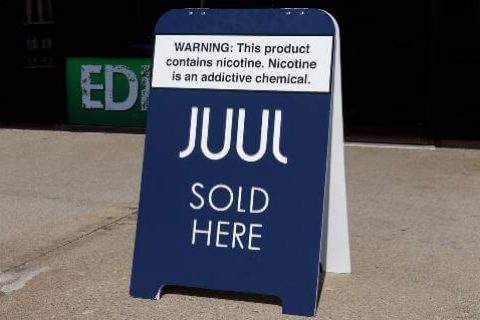
Juul and E-Cigarettes
E-cigarettes are devices that use batteries and a heating element to turn flavored liquids into a vapor that can be inhaled. Often marketed as a safer alternative to tobacco cigarettes, virtually all vaping liquids contain highly addictive nicotine. E-cigs, including Juul, have been linked to seizures and other serious side effects.
- Medically reviewed by Joshua Mansour, M.D.
- Last update: March 10, 2025
Electronic cigarettes are more popularly known as e-cigarettes, e-cigs or vape pens. They include vape pens, vaporizers, e-pens, e-pipes, e-hookahs and e-cigars, which are all classified as electronic nicotine delivery systems, or ENDS.
One of the most popular e-cigarettes is Juul, but hundreds of different e-cigarette brands are currently available to consumers. In June 2022, the FDA banned Juul from selling it’s products after finding the company provided “insufficient and conflicting data” on risks.
However, the next day, Juul filed an emergency appeal that allowed it to continue selling its products until the FDA finishes a second review of safety data. In September 2022, the e-cigarette maker sued the FDA for refusing to disclose documents that led to the ban.
Using e-cigs is referred to as vaping or juuling. E-cigarettes deliver a liquid to users as a vapor instead of a harsher smoke. The liquid contains a mixture of nicotine, propylene glycol, glycerin, and sometimes flavorings and other unknown ingredients.
Users have reported a growing list of potential e-cigarette side effects such as seizures, strokes, respiratory failure and bronchiolitis obliterans organizing pneumonia, or BOOP.
Among the most serious side effects is EVALI, which stands for e-cigarette, or vaping, product use associated lung injury. The condition causes severe lung damage that frequently requires patients to use a mechanical ventilator.
By early 2020, the U.S. Centers for Disease Control and Prevention determined that vitamin E acetate was “strongly linked” to the EVALI outbreak. The chemical is sometimes used as a thickening agent in vape fluids containing THC – the psychoactive ingredient in marijuana.
The CDC received 2,807 reports of EVALI cases or deaths as of Feb. 18, 2020. According to data from Jan 2020, of the 2,022 hospitalized EVALI patients, about 82 percent had vaped THC, the active ingredient in marijuana. But 14 percent had vaped nicotine products exclusively.
The lung injury outbreak has been followed by a wave of states and cities ordering e-cigarette bans in their jurisdictions.
What Is Juul?
Juul is the most popular e-cigarette marketed in the United States. The brand accounts for about 75 percent of all e-cigs sold. It is one of just five brands that control about 97 percent of the e-cigarette market. The other four are Vuse, MarkTen, Blu and Logic.
The trendy e-cigs appeal to young adults and teens who often don’t realize Juul products are e-cigarettes or contain nicotine. Public health researchers have found teens using the term “juuling” instead of “vaping” to distinguish Juul from other e-cigs even though the two activities are the same.
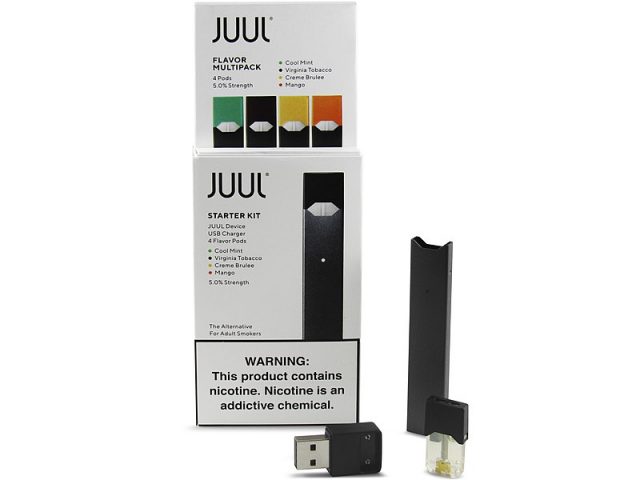
Source: Wikimedia Commons
When Juul first hit the market in 2015, its vape liquid contained much higher levels of nicotine than e-cigs that had already been on the market. Each Juul pod contains as much nicotine as 20 regular cigarettes, according to the Centers for Disease Control and Prevention.
Juul’s sleek design and addictive nicotine are credited for the device’s widespread popularity with teens and young adults, as well as Juul’s rapid dominance of the e-cigarette market.
-
2004
Stanford University grad students James Monsees and Adam Bowen come up with the idea for Ploom, a company to manufacture tobacco vaporizers.
-
2007
Bowen and Monsees raise $900,000 to found Ploom as a tech startup in San Francisco.
-
2015
After rebranding as Pax Labs, the company launches Juul.
-
2016
Juul sales increase 700 percent in one year.
-
2017
Pax Labs spins off Juul Labs as an independent company.
-
April 2018
The FDA begins a crackdown on Juul and other e-cigs to reduce youth vaping, while launching an investigation into the company.
-
Oct. 2018
Juul becomes the biggest selling e-cigarette in the U.S., controlling more than 70 percent of the e-cig market.
-
Dec. 18, 2018
The U.S. Surgeon General declares that America is facing an “epidemic of e-cigarette use” among teens and young adults.
-
Dec. 20, 2018
Big Tobacco giant Altria, maker of Marlboro cigarettes, buys a 35 percent share of Juul.
-
April 3, 2019
The FDA announces it is investigating what will become more than 125 cases of seizures apparently linked to vaping.
-
July 25, 2019
Wisconsin health officials announce eight cases of severe lung injury related to vaping.
-
Sept. 9, 2019
FDA issues a warning letter to Juul Labs for its marketing practices.
-
Sept. 25, 2019
Juul CEO Kevin Burns resigns after apologizing for the nation’s teen vaping epidemic.
-
Oct. 2, 2019
A federal judicial panel transfers Juul lawsuits filed across the United States to a court in San Francisco.
-
Oct. 15, 2019
The first wrongful death lawsuit against Juul is filed by the family of an 18-year-old who died after being hospitalized for a severe lung condition.
-
Oct. 29, 2019
The CDC reports 1,888 confirmed or suspected cases of e-cigarette, or vaping, product use associated lung injury in 49 states, the District of Columbia and the U.S. Virgin Islands. At least 37 people in 24 states have died from the lung injuries.
-
June 23, 2022
FDA issued marketing denial orders (MDOs) and banned Juul from selling its products in the U.S.
-
June 24, 2022
Juul filed an emergency appeal, and the U.S. Court of Appeals issued a temporary stay on the ban.
-
July 5, 2022
FDA stayed the marketing denial order and is conducting an additional review of Juul's marketing application.
-
September 6, 2022
Juul agreed to pay $438.5 million to 33 states to settle an investigation into its marketing to young people.
-
September 20, 2022
Juul sued the FDA for refusing to disclose documents the agency used to ban its products.
-
December 2022
Juul reached a settlement with 10,000 plaintiffs in multidistrict legislation for an undisclosed amount.
-
January 2023
Juul receives preliminary approval for a $255 million settlement to resolve an economic loss class-action lawsuit.
-
March 2023
Juul agreed to pay $23.8 million to Chicago over deceptive marketing claims and selling vaping products to underage users.
In September 2019, the Wall Street Journal reported that the FDA had opened a criminal investigation into Juul Labs to determine whether the company used deceptive advertising and targeted minors. Juul CEO Kevin Burns resigned in September 2019 after apologizing for the teen vaping epidemic in the United States.
As of December 2022, Juul faces 4,908 e-cigarette lawsuits combined in a mass litigation in a San Francisco federal court. The lawsuits claim the company marketed nicotine products to minors and Juul devices led to serious health problems. Lawyers expect people to file more Juul lawsuits in the litigation as time passes.
In January 2023, a California judge gave preliminary approval for Juul’s $255 million offer to settle a class action involving economic loss. Members of the class claimed they would have paid less or not bought Juul’s products had the company not falsely advertised. An estimated 200,000 to two million class members will receive payments.
Who Uses Juul and Other E-Cigarettes?
Young people are more likely than adults to use Juul or other e-cigarettes in the United States, according to the CDC.
The health protection agency reports that 2.8 percent of American adults used e-cigarettes in 2017. Among adult e-cig users, 58.8 percent also continued to smoke tobacco cigarettes while 29.8 percent were former tobacco smokers. Another 11.4 percent of e-cig users had never been regular tobacco smokers.
A 2018 report from Truth Initiative, an anti-smoking group, found that 15- to 17-year-olds were 16 times more likely to have used a Juul e-cig than older age groups. The report also found more than half of Juul users were younger than 18 the first time they tried the device.
Teen Use of Juul and Other E-Cigarettes
Teen use of e-cigarettes has increased rapidly since the introduction of Juul in 2015. In 2018, the U.S. Surgeon General’s office found about 20 percent of high school students used an e-cigarette. The Surgeon General declared an “epidemic of youth e-cigarette use.” He pointed to surges in the number of teens using e-cigs and the dangers of nicotine to brain development in young people.
“We’re at risk of dealing with nicotine addiction, several health concerns and potential lung diseases that we hadn’t really seen previously or at this rate from a particular product,” Dr. Joshua Mansour, a Los Angeles-based oncologist, told Drugwatch.
In September 2022, Juul agreed to pay $438.5 million to resolve allegations brought by 33 states that the company marketed its products to teens by using young-looking models on social media and having launch parties, among other tactics.
Student Vaping Statistics
- About 3.62 million middle and high school students used e-cigarettes in 2018.
- From 2017 to 2018, e-cig use increased 78 percent among high school students and 48 percent among middle school students.
- In 2018, 20.8 percent of high school students and 4.9 percent of middle schoolers reported having used an e-cigarette.
Source: U.S. Food and Drug Administration
Early results from a national survey of teen tobacco and e-cig use show vaping among teens continued to rise well into 2019. The National Institute on Drug Abuse found 1 in 4 high school seniors had vaped nicotine products within the last month. For 10th graders, the rate was 1 in 5, and for 8th graders, it was 1 in 11.
FDA Bans E-Cig Flavors
In November 2018, the FDA announced restrictions on the sale of flavored e-cigarette vape fluids.
Flavored vape fluids have been criticized as a marketing ploy to lure teens and young adults to vaping. Federal regulators have targeted flavored vape liquids to rein in underage sales and use.
The agency said it would ban all e-cigarette flavors except tobacco, mint and menthol in retail stores. Fruity or sweet e-cig flavors can now only be purchased through age-restricted stores or online merchants that can verify a buyer’s age.
“These electronic cigarettes are also marketed for their flavors that are more appealing than the musty, odorous tobacco cigarettes have been and are targeted to a different generation,” Mansour said.
In August 2019, the FDA notified four companies to remove 44 flavored e-cigarette fluids and hookah tobaccos from sale in the United States. The agency crackdown underlined the FDA’s muscle-flexing on its authority to require FDA approval for new flavored products.
Juul announced in October 2019 that it would eliminate all fruity flavors for sale in the United States. The company had already suspended sales of most of its flavored pods in stores in November 2018, but continued to sell them online.
Vaping vs. Smoking
Vaping may be safer than smoking for adults past their mid-20s who already smoke. But e-cigarettes are not safe for nonsmokers, teens, young adults or pregnant women, according to the CDC.
In September 2019, the FDA ordered Juul to stop advertising use of its products as safer than smoking. The agency sent a warning letter to Juul Labs, saying the company had illegally marketed its products as safer than tobacco.
The FDA said the company marketed its products as “modified risk tobacco products” without FDA clearance. The agency stressed that there was no scientific proof that Juul products posed less risk or were less harmful than tobacco products.
“[B]efore marketing tobacco products for reduced risk, companies must demonstrate with scientific evidence that their specific product does in fact pose less risk or is less harmful,” the FDA said in a statement.
Research is mixed on whether vaping is safer than smoking, and e-cigs like Juul are so new that not a lot of research has been done.
“There has been this facade that, ‘Oh, e-cigarettes are not as bad for you,’” Mansour said. “From time and experience, we have much more information and data regarding the several dangers of traditional cigarettes including, but not limited to cancer, COPD, emphysema, and heart disease. However, we don’t fully know the risks from e-cigarettes.”
Can Vaping Help People Quit Smoking?
The FDA has never approved an e-cigarette as a smoking cessation device. Studies into whether the devices help people quit smoking have yielded mixed results.
In 2008, just after e-cigarettes showed up in the U.S. and Europe, the World Health Organization urged marketers to remove claims that e-cigarettes are a safe and effective way to quit smoking because no scientific evidence was available to support those claims.
A 2019 study in the journal Addiction estimated that vaping may have helped as many as 70,000 smokers in the United Kingdom kick the habit. But the authors warned that cultural differences may prevent the results from being repeated elsewhere.
A French study from the same year found similar results, but also it found that e-cig use among smokers increased the risk of relapse into tobacco use.
In the United States, marketing e-cigs to teens may have helped hook more young people on nicotine and tobacco.
A 2015 study in the Journal of the American Medical Association found that teens who took up vaping were three times more likely to start smoking within six months compared to teens who didn’t vape. A Yale University study in 2018 found the switch from vaping to tobacco cigarettes could happen in as little as one month.
“We won’t fully understand the range of vaping’s harmful effects for some time to come,” Mansour said. “But just like tobacco and cigarettes in the past, it took several decades for us to really understand what the full harmful effects of those products were.”
How Do E-Cigarettes Work?
E-cigarettes come in a wide variety of shapes, sizes and designs, but they all work in pretty much the same way. They each have a mouthpiece, a battery, a heating element and a container for the vaping fluid, which is sometimes part of the mouthpiece.
-
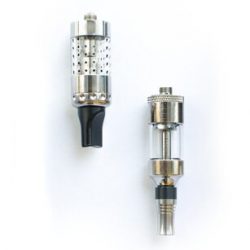 CartridgeHolds the liquid mixture with varying dosages of nicotine, flavorings and chemicals.
CartridgeHolds the liquid mixture with varying dosages of nicotine, flavorings and chemicals. -
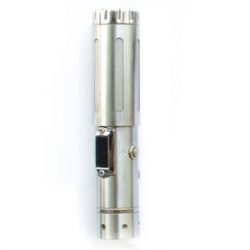 Heating DeviceTo convert the liquid to a vapor (vaporizer).
Heating DeviceTo convert the liquid to a vapor (vaporizer). -
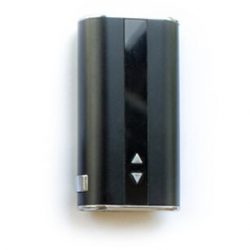 Power SourceUsually a battery.
Power SourceUsually a battery.
When the user puffs on the e-cigarette’s mouthpiece, the battery-operated heating element activates. The heating element vaporizes the e-liquid stored in the cartridge and releases an aerosol or vapor, which the user inhales.
How Much Nicotine Is in Juul and Other E-Cigarettes?
Virtually all e-liquids used in Juul and other e-cigarettes contain nicotine. The exact level of nicotine varies by brand.
For example, some Juul pods contain more nicotine than many other e-cigarettes.
According to Cleveland Clinic, one type of Juul pod contains 0.7mL (or 59 mg/mL) of nicotine per pod, which is approximately equivalent to 200 puffs of a cigarette. That’s about one pack of cigarettes worth of nicotine in one pod. Juul’s maker has claimed that it delivers nicotine up to 2.7 times faster than other e-cigarettes, according to Truth Initiative.
Labeling isn’t a reliable way to find out how much nicotine is in an e-cigarette because studies have found many products are mislabeled, according to Truth Initiative.
In October 2019, US Rep. Raja Krishnamoorthi announced a new bill that would put a cap on the amount of nicotine in e-cigarettes to 20 mg/mL, CNN reported. This cap is already in place in Europe.
Currently, there is no limit on the amount of nicotine in e-cigarettes in the United States.
Explosion Recalls
Some brands of e-cigarettes have been known to overheat and possibly explode, resulting in burns and other severe injuries for e-cig users. The malfunction is likely due to the use of lithium-ion batteries to power the e-cigarettes.
Incidents of e-cigarette explosions have been reported to the U.S. Fire Administration dating back to 2009, just two years following the release of e-cigs into the U.S. market.
- 195 incidents of explosions and fires involving e-cigarettes were reported by U.S. media between January 2009 and December 2016.
- These incidents resulted in 133 acute injuries.
- 38 injuries were considered severe.
- 121 fire and explosion incidents happened while the device was in a pocket or in use.
- The shape and construction of e-cigarettes can make them more likely than other products containing lithium-ion batteries to act as “flaming rockets” as a result of battery failures.
The FDA has offered some recommendations to help e-cigarette users avoid potential battery malfunctions and explosions.
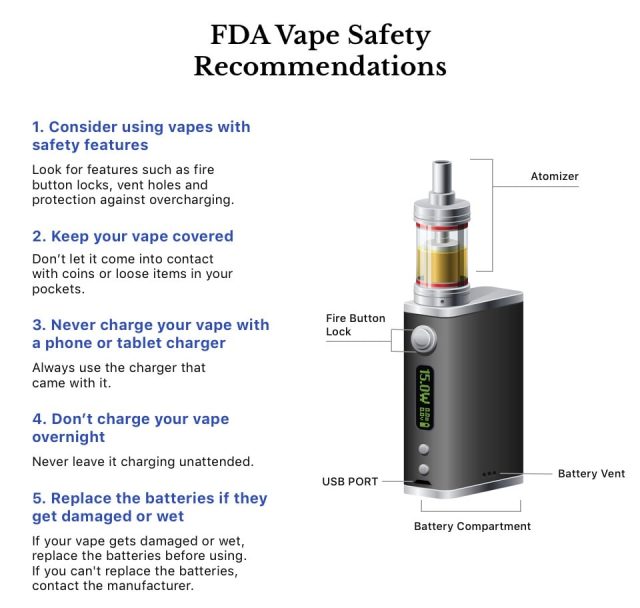
Common Questions About E-Cigarettes
What are the side effects of Juul and other e-cigarettes?
Common side effects of using Juul and other e-cigarettes include coughing, dizziness and dry mouth. Serious vaping side effects may include severe lung injuries, seizures, and nicotine addiction and poisoning.
Have e-cigarettes been banned?
After the e-cigarette lung injury outbreak, certain states and cities made the decision to ban or restrict Juul and other vaping products. Although there is no nationwide e-cigarette ban, the FDA announced a ban on almost all flavored vaping cartridges and pods on Jan 2, 2020.
Is it hard to quit vaping?
Quitting vaping can be difficult because you’re managing nicotine withdrawal. Setting a routine and following through on it can help you control your vape cravings.
Calling this number connects you with a Drugwatch.com representative. We will direct you to one of our trusted legal partners for a free case review.
Drugwatch.com's trusted legal partners support the organization's mission to keep people safe from dangerous drugs and medical devices. For more information, visit our partners page.

